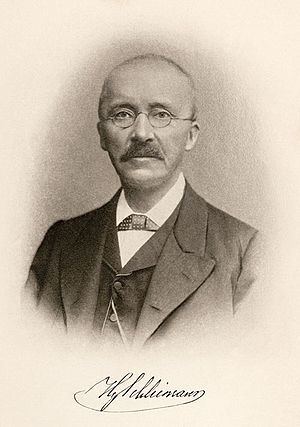Mask of Agamemnon facts for kids
Quick facts for kids Mask of Agamemnon |
|
|---|---|

The mask in the National Archaeological Museum of Athens
|
|
| Material | Gold |
| Created | 1550–1500 BC |
| Discovered | 1876 at Mycenae, Greece by Heinrich Schliemann |
| Present location | National Archaeological Museum, Athens |
The Mask of Agamemnon is a special gold mask found in ancient Mycenae, a city in southern Greece. It's called a funerary mask because it was placed on the face of someone who had died. This amazing mask is now on display at the National Archaeological Museum of Athens. One historian, Cathy Gere, even called it the "Mona Lisa of prehistory" because it's so famous and important.
A German archaeologist named Heinrich Schliemann found this mask in 1876. He thought he had discovered the body of Agamemnon, a famous king from ancient Greek stories. Agamemnon was a leader in the Trojan War, which is told about in the epic poem Iliad. However, today's archaeologists believe the mask is much older. It was made around 1600 BC, which is about 300 to 400 years before the Trojan War is thought to have happened.
Finding the Gold Mask
In 1876, Heinrich Schliemann discovered this gold mask. He found it in a special burial place called a shaft tomb at a site known as Grave Circle A, Mycenae. A shaft tomb is like a deep pit dug into the ground for burials.
Inside Grave Circle A, archaeologists found the remains of eight men. All of these men were buried with weapons. But only five of them had masks, and these were found in Graves IV and V. The large amounts of gold and the carefully made items found with the bodies show that these people were very important and wealthy.

Schliemann named the mask after the legendary Greek king Agamemnon. He believed this discovery proved that the Trojan War was a real event. The Mask of Agamemnon was made from a thick sheet of gold. It was heated and hammered into shape against a wooden background. The fine details were then added using a sharp tool.
After his exciting discoveries, Schliemann sent a message to King George of Greece. He famously telegraphed the king, saying, "I have gazed upon the face of Agamemnon." Schliemann even named his son after the legendary king. Later in his life, Schliemann began to have doubts about whether the mask truly belonged to Agamemnon. He was quoted saying, "So this is not Agamemnon... these are not his ornaments? All right, let's call him Schulze."
Is the Mask Real?
Over the last few decades, some experts have questioned if the Mask of Agamemnon is truly authentic. This means they wondered if it was really from ancient times or if it might have been faked. Archaeology magazine has even published articles discussing both sides of this debate.
When Schliemann was digging at the Shaft Graves, the Greek Archaeological Society was watching his work closely. They sent Panagiotis Stamatakis to be the director, or ephor, of the excavation. He kept a very close eye on everything Schliemann did.
Some people who believe the mask might be a fake point to Schliemann's past. He was known for sometimes adding artifacts to his digs that came from other places. They suggest that Schliemann could have had the mask made and then secretly placed it in the excavation site.
However, those who defend the mask's authenticity have arguments too. They point out that the excavation was closed for a Sunday holiday and due to rain. It was only allowed to reopen when Stamatakis had reliable witnesses present. The other three masks were found on November 28th, and the Mask of Agamemnon was found on November 30th. This suggests it would have been hard to fake.
Another point of debate is the mask's style. The Mask of Agamemnon looks different from the other three masks found. It is more three-dimensional, not flat. Its beard is pointed and full, with a handlebar mustache, which is unusual for Mycenaean art. The eyes are shown as both open and shut at the same time.
However, defenders of the mask say that some features, like the shape of the lip and the triangular beard, are similar to other gold items found in the same grave, such as a gold lion-head rhyton (a type of drinking vessel). They also argue that Schliemann's reputation for faking things has been greatly exaggerated.
Most modern archaeological research today suggests that the mask is genuine. However, it is believed to be much older than the time of the Trojan War, dating back 300 to 400 years earlier. Some experts even think it might be from around 2500 BC.
See also
- Achaeans (Homer)
- Teres I
- Golden Bust of Septimius Severus


